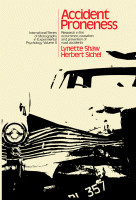Browse content
Table of contents
Actions for selected chapters
- Full text access
- Book chapterNo access
REFERENCES
Pages 457-463 - Book chapterNo access
AUTHOR INDEX
Pages 465-467 - Book chapterNo access
SUBJECT INDEX
Pages 469-476 - Book chapterNo access
OTHER TITLES IN THE SERIES IN EXPERIMENTAL PSYCHOLOGY
Page 477
About the book
Description
Accident Proneness: Research in the Occurrence, Causation, and Prevention of Road Accidents deals with concept of accident proneness. The concept has had a checkered career, from the early British work whose high scientific standard has been universally acknowledged, through a period when the concept was extended beyond the sound basis which had been laid, to a period of reaction when doubt was thrown on the very existence of such a notion. The book examines in detail the arguments brought forward by the proponents of both sides, and, more importantly, studies in detail the facts and figures quoted in support. The book is organized into two sections: the first deals with the validity and usefulness of the concept of accident proneness; the second discusses new statistical techniques to evaluate the concept of accident proneness. The book demonstrates the existence of personality-related behavior patterns, which make people differentially prone to traffic accidents. This book is an important contribution to an important field. It is written in a style which should make it understandable (and even enjoyable) to more than the psychological experts to whom it is addressed in the first place.
Accident Proneness: Research in the Occurrence, Causation, and Prevention of Road Accidents deals with concept of accident proneness. The concept has had a checkered career, from the early British work whose high scientific standard has been universally acknowledged, through a period when the concept was extended beyond the sound basis which had been laid, to a period of reaction when doubt was thrown on the very existence of such a notion. The book examines in detail the arguments brought forward by the proponents of both sides, and, more importantly, studies in detail the facts and figures quoted in support. The book is organized into two sections: the first deals with the validity and usefulness of the concept of accident proneness; the second discusses new statistical techniques to evaluate the concept of accident proneness. The book demonstrates the existence of personality-related behavior patterns, which make people differentially prone to traffic accidents. This book is an important contribution to an important field. It is written in a style which should make it understandable (and even enjoyable) to more than the psychological experts to whom it is addressed in the first place.
Details
ISBN
978-0-08-006916-6
Language
English
Published
1971
Copyright
Copyright © 1971 Elsevier Ltd. All rights reserved.
Imprint
Pergamon
